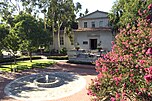
Back Claremont Colleges Finnish Claremont Colleges French クレアモント・カレッジズ Japanese 클레어몬트 칼리지 Korean Клермонтские колледжи Russian Claremont Colleges SIMPLE Liên minh Đại học Claremont Vietnamese 克萊蒙特諸校 Chinese
Former name | Claremont University Consortium (until 2017[1][2]) |
|---|---|
| Type | Private consortium |
| Established | October 14, 1925[3][4] |
| Founder | James Blaisdell |
| Endowment | $27 million (2019)[5][a] |
| Budget | $47 million (2019)[5][b] |
| CEO | Stig Lanesskog[4] |
| Students | Approx. 8500[6] |
| Location | , , United States 34°06′09″N 117°42′45″W / 34.10250°N 117.71250°W |
| Campus | Suburban, 546 acres (221 ha)[6] |
| Nickname | Pomona-Pitzer Sagehens Claremont-Mudd-Scripps Stags and Athenas |
Sporting affiliations | NCAA Division III – SCIAC |
| Website | www |
The Claremont Colleges (known colloquially as the 7Cs) are a consortium of seven private institutions of higher education located in Claremont, California, United States. They comprise five undergraduate colleges (the 5Cs)—Pomona College, Scripps College, Claremont McKenna College (CMC), Harvey Mudd College, and Pitzer College—and two graduate schools—Claremont Graduate University (CGU) and Keck Graduate Institute (KGI). All the members except KGI have adjoining campuses, together covering roughly 1 sq mi (2.6 km2).
The consortium was founded in 1925 by Pomona College president James A. Blaisdell, who proposed a collegiate university design inspired by Oxford University. He sought to provide the specialization, flexibility, and personal attention commonly found in small colleges, but with the resources of a large university.[7] The consortium has since grown to roughly 8,500 students[8] and 3,600 faculty and staff,[8] and offers more than 2,000 courses every semester.[9] The colleges share a central library, campus safety services, health services, and other resources, managed by The Claremont Colleges Services (TCCS). Among the undergraduate schools, there is significant social interaction and academic cross-registration, but each college maintains a distinct identity.[10][11][12]
Admission to the Claremont Colleges is considered highly selective.[13] For the Class of 2020 admissions cycle, four of the five most selective liberal arts colleges in the U.S. by acceptance rate were among the 5Cs (the five undergraduate colleges), and the remaining college, Scripps, had the second-lowest acceptance rate among women's colleges.[14] The Fiske Guide to Colleges describes the consortium as "a collection of intellectual resources unmatched in America."[15]
- ^ "Claremont University Consortium Is Changing Its Name". The Claremont Colleges Services. Retrieved May 11, 2020.[permanent dead link]
- ^ Rodriguez, Monica (December 9, 2017). "The Claremont University Consortium legally changes name to The Claremont Colleges". San Gabriel Valley Tribune. Archived from the original on January 22, 2021. Retrieved August 29, 2020.
- ^ "History of the Colleges". The Claremont Colleges Services. Archived from the original on December 14, 2019. Retrieved August 3, 2020.
- ^ a b "CEO Welcome". The Claremont Colleges Services. Archived from the original on April 14, 2020. Retrieved May 10, 2020.
- ^ a b "The Claremont Colleges 2018–2019 Financial Report" (PDF). The Claremont Colleges. Retrieved August 3, 2020.[permanent dead link]
- ^ a b "The Claremont Colleges". www.claremont.edu. Archived from the original on May 14, 2020. Retrieved May 10, 2020.
- ^ James A. Blaisdell, the creator of the Claremont Colleges, declared in 1923 "My own very deep hope is that instead of one great, undifferentiated university, we might have a group of institutions divided into small colleges—somewhat of an Oxford type—around a library and other utilities which they would use in common. In this way, I should hope to preserve the inestimable personal values of the small college, while securing the facilities of the great university."
- ^ a b "The Claremont Colleges". Claremont Colleges. Retrieved February 10, 2021.
- ^ "The Claremont Colleges". Claremont Colleges. Archived from the original on April 29, 2021. Retrieved February 10, 2021.
- ^ Fiske 2021, pp. 146–147.
- ^ Felch, Trevor (October 22, 2019). "The 12 best college towns in California". San Francisco Chronicle. Archived from the original on April 18, 2021. Retrieved March 12, 2021.
- ^ Ferrall, Victor E. (2011). "Cooperating". Liberal Arts at the Brink. Cambridge, Mass.: Harvard University Press. p. 85. ISBN 9780674060883.
- ^ Characterizations of the reputation of the Claremont Colleges:
- Marantos, Jeanette (October 4, 2019). "Four Hours: Claremont is vintage, delicious and delightfully smart". Los Angeles Times. Archived from the original on January 24, 2022. Retrieved April 7, 2020.
highly respected
- Peterson, Ivan (January 28, 1973). "Cluster of 6 Colleges in Claremont, Calif Is Thriving on Diversity". The New York Times. Archived from the original on April 18, 2021. Retrieved April 7, 2020.
the cluster arrangement seems to offer the advantages of size, diversity, smallness and intimacy—all at the same time.
- Vise, Daniel de (September 13, 2011). "At the top of the U.S. News rankings, a five-way tie". The Washington Post. Archived from the original on January 24, 2022. Retrieved April 7, 2020.
small consortium of private campuses that have proven a model of efficiency and seem to grow more prestigious every year
- Wharton, David (February 28, 2019). "As the likes of USC and UCLA have struggled, tiny Pomona-Pitzer has big basketball dreams". Los Angeles Times. Archived from the original on November 7, 2020. Retrieved April 7, 2020.
The Claremont Colleges consistently rank among the best liberal arts schools nationwide
- Winton, Richard (April 8, 2001). "Claremont Is Divided Over New Campus". Los Angeles Times. Archived from the original on January 24, 2021. Retrieved April 7, 2020.
prestigious liberal arts schools
- Marantos, Jeanette (October 4, 2019). "Four Hours: Claremont is vintage, delicious and delightfully smart". Los Angeles Times. Archived from the original on January 24, 2022. Retrieved April 7, 2020.
- ^ "Ivy League Admissions Stats & Acceptance Rates, Class of 2020". Archived from the original on July 16, 2016. Retrieved July 12, 2016.
- ^ Hurst, Allison L. (October 18, 2019). Amplified Advantage: Going to a "Good" College in an Era of Inequality. Lanham, MD: Lexington Books. pp. 19–20. ISBN 9781498589666. Archived from the original on January 24, 2022. Retrieved April 7, 2020.
Cite error: There are <ref group=lower-alpha> tags or {{efn}} templates on this page, but the references will not show without a {{reflist|group=lower-alpha}} template or {{notelist}} template (see the help page).
© MMXXIII Rich X Search. We shall prevail. All rights reserved. Rich X Search






